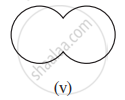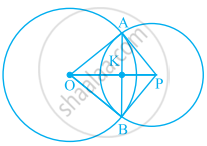Advertisements
Advertisements
Question
If three angles of a quadrilateral are 90° each, show that the given quadrilateral is a rectangle.
Solution
The given quadrilateral ABCD will be a rectangle, if its each angle is 90°
Since, the sum of interior angles of a quadrilateral is 360°.
∴∠A +∠B + ∠C + ∠D = 360°
⇒ 90° + 90° + 90° + ∠D = 360°
⇒ 270° + ∠D = 360°
⇒ ∠D = 360° – 270°
⇒ ∠D = 90°
Since, each angle of the quadrilateral is 90°. ∴The given quadrilateral is a rectangle.
APPEARS IN
RELATED QUESTIONS
Given here are some figures:
 |
 |
 |
 |
 |
 |
 |
 |
Classify each of them on the basis of the following:
- Simple curve
- Simple closed curve
- Polygon
- Convex polygon
- Concave polygon
Complete of the following, so as to make a true statement:
A quadrilateral has ....... sides.
Complete of the following, so as to make a true statement:
A quadrilateral has ...... angles.
In Fig. 16.19, ABCD is a quadrilateral.
How many pairs of opposite sides are there?

The four angles of a quadrilateral are as 3 : 5 : 7 : 9. Find the angles.
In Fig. 16.21, the bisectors of ∠A and ∠B meet at a point P. If ∠C = 100° and ∠D = 50°, find the measure of ∠APB.

In a quadrilateral ABCD, CO and DO are the bisectors of ∠C and ∠D respectively. Prove that \[∠COD = \frac{1}{2}(∠A + ∠B) .\]
The sum of the interior angles of a polygon is three times the sum of its exterior angles. Determine the number of sided of the polygon.
If the bisectors of two adjacent angles A and B of a quadrilateral ABCD intersect at a point O such that ∠C + ∠D = k ∠AOB, then find the value of k.
ABCDE is a regular pentagon. The bisector of angle A of the pentagon meets the side CD in point M. Show that ∠AMC = 90°.
Two opposite angles of a parallelogram are 100° each. Find each of the other two opposite angles.
In parallelogram ABCD, its diagonals intersect at point O. If OA = 6 cm and OB = 7.5 cm, find the length of AC and BD.

Observe the figure below and find out their name.

A diagonal of a rectangle is inclined to one side of the rectangle at 25º. The acute angle between the diagonals is ______.
If angles A, B, C and D of the quadrilateral ABCD, taken in order, are in the ratio 3 : 7 : 6 : 4, then ABCD is a ______.
What is the maximum number of obtuse angles that a quadrilateral can have?
The number of right angles in a straight angle is ______ and that in a complete angle is ______.
The number of common points in the two angles marked in figure is ______.
Using the information given, name the right angles in part of figure:
AE ⊥ CE
Using the information given, name the right angles in part of figure:
OP ⊥ AB
